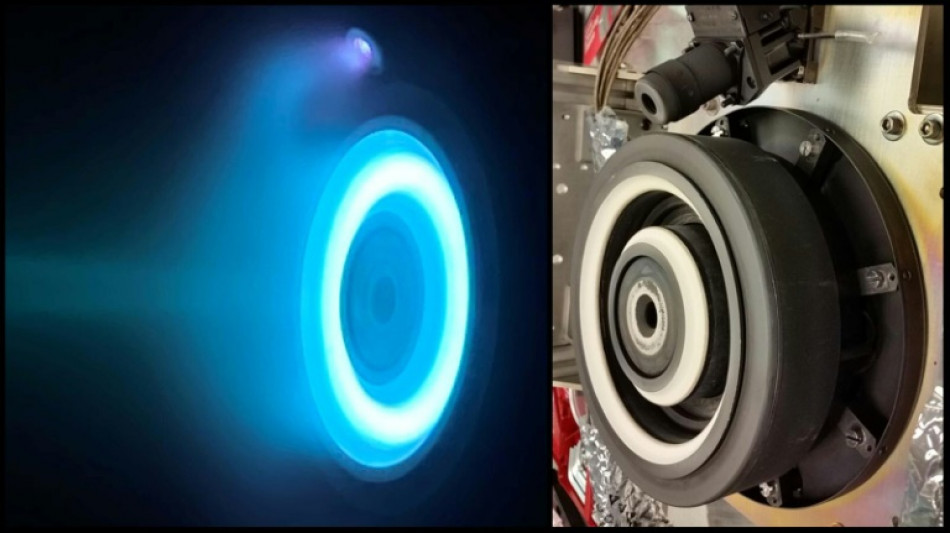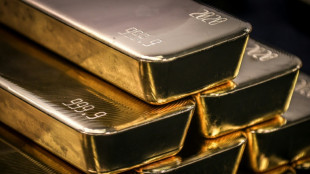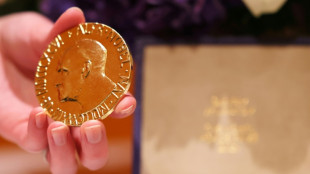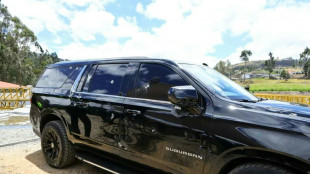
-
 Battling cancer made Vendee Globe win 'more complicated', says skipper Dalin
Battling cancer made Vendee Globe win 'more complicated', says skipper Dalin
-
England, Portugal, Norway closing in on 2026 World Cup

-
 Child protection vs privacy: decision time for EU
Child protection vs privacy: decision time for EU
-
Bear injures two in Japan supermarket, man killed in separate attack

-
 In Simandou mountains, Guinea prepares to cash in on iron ore
In Simandou mountains, Guinea prepares to cash in on iron ore
-
Morikawa says not to blame for 'rude' Ryder Cup fans

-
 Far right harvests votes as climate rules roil rural Spain
Far right harvests votes as climate rules roil rural Spain
-
'Return to elegance': highlights from Paris Fashion Week

-
 Britain's storied Conservative party faces uncertain future
Britain's storied Conservative party faces uncertain future
-
New Zealand's seas warming faster than global average: report

-
 Snakebite surge as Bangladesh hit by record rains
Snakebite surge as Bangladesh hit by record rains
-
Yankees deny Blue Jays playoff sweep as Mariners beat Tigers

-
 Australia police foil 'kill team' gang hit near daycare centre
Australia police foil 'kill team' gang hit near daycare centre
-
US, Qatar, Turkey to join third day of Gaza peace talks in Egypt

-
 Gold tops $4,000 for first time as traders pile into safe haven
Gold tops $4,000 for first time as traders pile into safe haven
-
Indian garment exporters reel under US tariffs

-
 NBA back in China after six-year absence sparked by democracy tweet
NBA back in China after six-year absence sparked by democracy tweet
-
Energy storage and new materials eyed for chemistry Nobel

-
 Trump unlikely to win Nobel Peace Prize, but who will?
Trump unlikely to win Nobel Peace Prize, but who will?
-
Qatar, Turkey to join third day of Gaza peace talks in Egypt

-
 Study finds women have higher genetic risk of depression
Study finds women have higher genetic risk of depression
-
Dolly Parton's sister calls for fan prayers over health issues

-
 On Trump's orders, 200 troops from Texas arrive in Illinois
On Trump's orders, 200 troops from Texas arrive in Illinois
-
Two bodies found, two missing after Madrid building collapse

-
 Panthers raise banner as NHL three-peat bid opens with win
Panthers raise banner as NHL three-peat bid opens with win
-
Nobel physics laureate says Trump cuts will 'cripple' US research

-
 UFC star McGregor suspended 18 months over missed drug tests
UFC star McGregor suspended 18 months over missed drug tests
-
Trump talks up Canada trade deal chances with 'world-class' Carney

-
 Ecuador president unharmed after apparent gun attack on motorcade
Ecuador president unharmed after apparent gun attack on motorcade
-
Lyon exact revenge on Arsenal, Barca thrash Bayern in women's Champions League

-
 Trump says 'real chance' to end Gaza war as Israel marks attacks anniversary
Trump says 'real chance' to end Gaza war as Israel marks attacks anniversary
-
Gerrard brands failed England generation 'egotistical losers'

-
 NFL fines Cowboys owner Jones $250,000 over gesture to fans
NFL fines Cowboys owner Jones $250,000 over gesture to fans
-
Bengals sign veteran quarterback Flacco after Burrow injury

-
 New prime minister inspires little hope in protest-hit Madagascar
New prime minister inspires little hope in protest-hit Madagascar
-
Is Trump planning something big against Venezuela's Maduro?

-
 EU wants to crack down on 'conversion therapy'
EU wants to crack down on 'conversion therapy'
-
French sex offender Pelicot says man who abused ex-wife knew she was asleep

-
 Trump says 'real chance' to end Gaza war as Israel marks Oct 7 anniversary
Trump says 'real chance' to end Gaza war as Israel marks Oct 7 anniversary
-
UK prosecutors to appeal dropped 'terrorism' case against Kneecap rapper

-
 Spain, Inter Miami star Alba retiring at end of season
Spain, Inter Miami star Alba retiring at end of season
-
EU targets foreign steel to rescue struggling sector

-
 Trump talks up Canada deal chances with visiting PM
Trump talks up Canada deal chances with visiting PM
-
Knight rides her luck as England survive Bangladesh scare

-
 Pro-Gaza protests flare in UK on anniversary of Hamas attack
Pro-Gaza protests flare in UK on anniversary of Hamas attack
-
Top rugby unions warn players against joining rebel R360 competition

-
 Outcast Willis 'not overthinking' England absence despite Top 14 clean sweep
Outcast Willis 'not overthinking' England absence despite Top 14 clean sweep
-
Trump says 'real chance' of Gaza peace deal

-
 Macron urged to quit to end France political crisis
Macron urged to quit to end France political crisis
-
No.1 Scheffler seeks three-peat at World Challenge


Five things to know about NASA's mission to a metal world
For the first time ever, a NASA probe is set to journey to an object composed not of rock, ice, or gas, but metal: the asteroid Psyche.
By studying this space oddity, scientists hope to learn more about the inner cores of rocky planets such as our own -- or, potentially catalog a previously unknown class of cosmic body.
Here are some big numbers and fun facts to dazzle your friends with about the mission.
- $10 quadrillion -
If Psyche were mineable, its iron, nickel and gold deposits could be worth an eye-watering $10,000 quadrillion (that's $10,000,000,000,000,000,000), according to an estimate reported by Forbes magazine.
But Lindy Elkins-Tanton, the mission's principal investigator who was responsible for that calculation, said it's nothing more than a "fun intellectual exercise with no truth to it."
"We have zero technology as a species to bring Psyche back to Earth," she said in a recent briefing. Attempting to do so could backfire by causing an apocalyptic collision -- but even if the endeavor were successful, it would flood the metals market, reducing their value to zero, she said.
- An electric voyage -
The Psyche probe will blast off on a SpaceX Falcon Heavy rocket, but to complete its 2.2 billion-mile (3.6 billion-kilometer) journey, it will turn to a far more efficient form of propulsion.
Psyche's solar arrays convert light into electricity, providing the power for its four solar electric or "Hall-effect" thrusters. These use electromagnetic fields to accelerate and expel ions (charged atoms) of xenon, the same inert gas used in car headlights and plasma TVs.
While the resulting blue glow is evocative of Star Trek, it's no warp drive: the actual force it exerts in a given moment is roughly equal to the weight of an AA battery in the palm of your hand.
But in the void of space, the probe will accelerate continuously to tens of thousands of miles an hour.
- Laser communications -
With deep space missions demanding higher and higher data rates, NASA is turning to laser-based systems to complement radio-frequency based communications.
Psyche will carry onboard a technology experiment, to demonstrate a "10 times augmentation of traditional telecom data rates," said Abi Biswas of NASA's Jet Propulsion Laboratory -- enabling the transmission of higher resolution images, more science data, and streaming video.
NASA will shoot its laser beam from a JPL facility on Table Mountain in California, with the spacecraft firing its signal back to Caltech's Palomar Observatory. The hope is eventually to use the technology on human missions to Mars.
- Gravity science -
Psyche has a suite of dedicated scientific instruments to probe the asteroid's chemical and mineral composition and look for signs of an ancient magnetic field.
But the science team will also use Psyche's trusty old radio system to probe the asteroid's gravity field using the Doppler Effect.
"We can look at the pitch or frequency of the radio waves coming from the antenna and figure out how fast the spacecraft is moving" as it orbits its target, said planetary scientist Ben Weiss, just as ambulance sirens have a higher pitch as they come towards you and lower as they move away.
By tracking the spacecraft's speed at different points around the asteroid, they can determine how "lumpy" the gravity field is, which in turn provides clues about the composition and structure of the interior.
- Less metal, more rock? -
Given its brightness, there was until recently broad consensus that Psyche was almost entirely metal -- consistent with the theory it is an exposed planetary core whose rocky crust and mantle were blown off in an ancient collision.
But the way it imposes gravity on neighboring bodies suggests it's less dense than all iron-body should be, according to a 2022 paper by researchers at Brown University.
One possibility they put forward is iron-spewing volcanoes brought metal up from Psyche's core to coat its surface above a rocky mantle -- effectively creating a structure akin to a metal sandwich.
It won't be until 2029, when the Psyche spacecraft reaches its destination, that we'll know for sure.
W.Huber--VB

